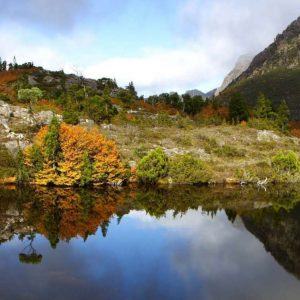Protecting Tasmania’s Wilderness and World Heritage Area
 The Tasmanian Wilderness World Heritage Area (TWWHA) covers almost a quarter of the land area of Tasmania and is recognised as being of Outstanding Universal Value under UNESCO’s World Heritage Convention.
The Tasmanian Wilderness World Heritage Area (TWWHA) covers almost a quarter of the land area of Tasmania and is recognised as being of Outstanding Universal Value under UNESCO’s World Heritage Convention.
Most UNESCO World Heritage sites meet only one or two of the ten criteria for that status. The Tasmanian Wilderness World Heritage Area meets seven out of ten criteria. Only one other place on earth—China’s Mount Taishan—meets that many criteria.
The TWWHA is one of the largest remaining temperate wilderness areas in the Southern Hemisphere, showing limited evidence of disturbance from post-European arrival activities evident elsewhere in Tasmania.
The status of this incredibly special area does not mean that the natural and cultural values contained within, are immune to threats such as climate change and invasive organisms – the latter threat likely to increase with changing climate and environmental conditions, increased visitation, and management activities.
Wildcare has a number of volunteer groups working in the TWWHA and the State Government’s recently released TWWHA Strategies on Biodiversity and on Climate Change Adaptation will illuminate issues that are front of mind for groups including:
- Friends of Maatsuyker Island
- Friends of Melaleuca
- Friends of the OBP
- Wildcare Cradle Mountain Volunteers
- Wildcare SPRATS (Sea Spurge Remote Area Teams)
- Friends of Mt Field
- Wildcare Coastal Custodians
- Wildcare Friends of the Penguin Cradle Trail (partly)
- Friends of the Franklin River and,
- Karst Care
BIOSECURITY
The occurrence of severe weather and fire events in the TWWHA, such as occurred in 2019, may increase the risk of entry and dispersal of weeds, pests and diseases. Such events can also place additional stresses on native plant and animal populations, rendering them more susceptible to diseases and competition from pests and weeds.
The Tasmanian Wilderness World Heritage Area Biosecurity Strategy 2021-2031, recently released by the Department of Primary Industries, Parks, Water and Environment, aims to guide decision making and provide direction on minimising the risks and impacts of invasive organisms (weeds, pests and diseases) on the natural and cultural values of the TWWHA and recognises the contribution that groups such as Wildcare make to this effort.
The Strategy identifies seven goals to address biosecurity risks in the TWWHA and associated actions include improving leadership, planning, communication, documentation, training and education, research, compliance, and emergency response.
CLIMATE CHANGE
The TWWHA Natural Values Climate Change Adaptation Strategy 2021-2031 has been developed from the most up-to-date knowledge gathered from the scientific and protected area management community and delivers practical information, actions and tools to manage risks, reduce impacts and realise benefits to the natural values of TWWHA.
This Strategy adds to the climate change work undertaken over the past 15 years, led by the DPIPWE’s Natural and Cultural Heritage Division. This program of work has undertaken risk assessments focusing on geodiversity, flora, and fauna values respectively, and has established a suite of monitoring programs to track the condition of values considered to be at greatest risk of climate change impacts.
